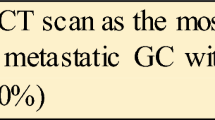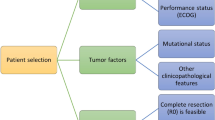Abstract
Background
The aims of this study were to evaluate the role of surgery in the management of patients with intraabdominal metastases from melanoma and to investigate the neutrophil to lymphocyte ratio (NLR) as prognostic factor in this group of patients.
Methods
Altogether, 44 patients who underwent surgery for Intraabdominal metastases from melanoma with curative, cytoreductive, or palliative intent were analyzed.
Results
There were 77 intraabdominal organ resections performed during the 44 operations. R0 resection was achieved in 19 (43 %) cases. Factors associated with R0 resection were an absence of extra-abdominal metastases, low serum lactate dehydrogenase, involvement of fewer than three sites, and the presence of fewer than three metastatic lesions. The 1-, 3-, and 5-year overall survival rates were, respectively, 79, 66, and 44 % in the curative intent group; 36, 18, and 9 % in the cytoreduction group; and 21, 0 and 0 % in the palliation group (curative intent vs. cytoreduction vs. palliation p < 0.001). By Cox’s multivariate analysis, the independent prognostic factors were time from excision of primary melanoma to the diagnosis of intraabdominal metastases, NLR, and residual disease after surgery.
Conclusions
Our results confirm the usefulness of major surgical interventions as reported in previous studies. We reviewed recent evidence that immunologic phenomena may explain the unexpectedly good response rate in patients with advanced disease. The simple estimation of the NLR has been advocated as a prognostic marker for several cancers. We show that it is likewise useful in metastatic melanoma. We stress the need for developing additional immunologic markers.


Similar content being viewed by others
References
Siegel R, Naishadham D, Jemal A (2012) Cancer statistics, 2012. CA Cancer J Clin 62:10–29
Siegel R, DeSantis C, Virgo K et al (2012) Cancer treatment and survivorship statistics, 2012. CA Cancer J Clin 62:220–241
Balch CM, Gershenwald JE, Soong SJ et al (2009) Final version of 2009 AJCC melanoma staging and classification. J Clin Oncol 27:6199–6206
Allen PJ, Coit DG (2002) The role of surgery for patients with metastatic melanoma. Curr Opin Oncol 14:221–226
Morton DL, Mozzillo N, Thompson JF et al (2007) An international, randomized, phase III trial of bacillus Calmette-Guerin (BCG) plus allogeneic melanoma vaccine (MCV) or placebo after complete resection of melanoma metastatic to regional or distant sites. J Clin Oncol 25:8508
Sanki A, Scolyer RA, Thompson JF (2009) Surgery for melanoma metastases of the gastrointestinal tract: indications and results. Eur J Surg Oncol 35:313–319
Wasif N, Bagaria SP, Ray P et al (2011) Does metastasectomy improve survival in patients with stage IV melanoma? A cancer registry analysis of outcomes. J Surg Oncol 104:111–115
Ollila DW, Gleisner AL, Hsueh EC (2011) Rationale for complete metastasectomy in patients with stage IV metastatic melanoma. J Surg Oncol 104:420–424
Walsh SR, Cook EJ, Goulder F et al (2005) Neutrophil–lymphocyte ratio as a prognostic factor in colorectal cancer. J Surg Oncol 91:181–184
Yamanaka T, Matsumoto S, Teramukai S et al (2007) The baseline ratio of neutrophils to lymphocytes is associated with patient prognosis in advanced gastric cancer. Oncology 73:215–220
Liu H, Tabuchi T, Takemura A et al (2008) The granulocyte/lymphocyte ratio as an independent predictor of tumour growth, metastasis and progression: its clinical applications. Mol Med Rep 1:699–704
Kishi Y, Kopetz S, Chun YS et al (2009) Blood neutrophil-to-lymphocyte ratio predicts survival in patients with colorectal liver metastases treated with systemic chemotherapy. Ann Surg Oncol 16:614–622
Wang S, Zhang Z, Fang F et al (2011) The neutrophil/lymphocyte ratio is an independent prognostic indicator in patients with bone metastasis. Oncol Lett 2:735–740
Kim YH, Choi WJ (2012) The effectiveness of postoperative neutrophils to lymphocytes ratio in predicting long-term recurrence after stomach cancer surgery. J Korean Surg Soc 83:352–359
Dindo D, Dermartines N, Clavien PA (2004) Classification of surgical complications: a new proposal with evaluation in a cohort of 6336 patients and results of a survey. Ann Surg 240:205–213
Gomez D, Farid S, Malik HZ et al (2008) Preoperative neutrophil-to-lymphocyte ratio as a prognostic predictor after curative resection for hepatocellular carcinoma. World J Surg 32:1757–1762
Chua W, Charles KA, Baracos VE et al (2011) Neutrophil/lymphocyte ratio predicts chemotherapy outcomes in patients with advanced colorectal cancer. Br J Cancer 104:1288–1295
Garcea G, Ladwa N, Neal CP et al (2011) Preoperative neutrophil-to-lymphocyte ratio (NLR) is associated with reduced disease-free survival following curative resection of pancreatic adenocarcinoma. World J Surg 35:868–872
Sharaiha RZ, Halazun KJ, Mirza F et al (2011) Elevated preoperative neutrophil:lymphocyte ratio as a predictor of postoperative disease recurrence in esophageal cancer. Ann Surg Oncol 18:3362–3369
Mallappa S, Sinha A, Gupta S et al (2012) Preoperative neutrophil to lymphocyte ratio >5 is a prognostic factor for recurrent colorectal cancer. Colorectal Dis 15:323–328
Joyce JA, Pollard JW (2009) Microenvironmental regulation of metastasis. Nat Rev Cancer 9:239–252
O’Byrne KJ, Dalgleish AG (2001) Chronic immune activation and inflammation as the cause of malignancy. Br J Cancer 85:473–483
Balkwill F, Mantovani A (2010) Cancer and inflammation: implications for pharmacology and therapeutics. Clin Pharmacol Ther 87:401–406
Grivennikov SI, Greten FR, Karin M (2010) Immunity, inflammation, and cancer. Cell 140:883–899
Hanahan D, Weinberg RA (2011) Hallmarks of cancer: the next generation. Cell 144:646–674
Mantovani A, Allavena P, Sica A et al (2008) Cancer-related inflammation. Nature 454:436–444
Sarraf KM, Belcher E, Raevsky E et al (2009) Neutrophil/lymphocyte ratio and its association with survival after complete resection in non-small cell lung cancer. J Thorac Cardiovasc Surg 137:4258
Halazun KJ, Hardy MA, Rana AA et al (2009) Negative impact of neutrophil-lymphocyte ratio on outcome after liver transplantation for hepatocellular carcinoma. Ann Surg 250:141–151
Aliustaoglu M, Bilici A, Seker M et al (2010) The association of pre-treatment peripheral blood markers with survival in patients with pancreatic cancer. Hepatogastroenterology 57:640–645
Liu H, Liu G, Bao Q et al (2010) The baseline ratio of neutrophils to lymphocytes is associated with patient prognosis in rectal carcinoma. J Gastrointest Cancer 41:116–120
Azab B, Bhatt VR, Phookan J et al (2012) Usefulness of the neutrophil-to-lymphocyte ratio in predicting short- and long-term mortality in breast cancer patients. Ann Surg Oncol 19:217–224
Perez DR, Baser RE, Cavnar MJ et al (2012) Blood neutrophil-to-lymphocyte ratio is prognostic in gastrointestinal stromal tumor. Ann Surg Oncol 20:593–599
Galon J, Franck P, Marincola FM et al (2012) Cancer classification using the Immunoscore: a worldwide task force. J Transl Med 10:205
Dunn GP, Old LJ, Schreiber RD (2004) The three Es of cancer immunoediting. Annu Rev Immunol 22:329–360
Vesely MD, Kershaw MH, Schreiber RD et al (2011) Natural innate and adaptive immunity to cancer. Annu Rev Immunol 29:235–271
Almand B, Resser J, Lindman B et al (2000) Clinical significance of defective dendritic cell differentiation in cancer. Clin Cancer Res 6:1755–1766
Salvadori S, Martinelli G, Zier K (2000) Resection of solid tumors reverses T cell defects and restores protective immunity. J Immunol 164:2214–2220
Evans C, Galustian C, Kumar D et al (2009) Impact of surgery on immunologic function: comparison between minimally invasive techniques and conventional laparotomy for surgical resection of colorectal tumors. Am J Surg 197:238–245
Conflict of interest
The authors have no conflicts of interest or financial support to declare regarding this manuscript.
Author information
Authors and Affiliations
Corresponding author
Rights and permissions
About this article
Cite this article
Cananzi, F.C.M., Dalgleish, A. & Mudan, S. Surgical Management of Intraabdominal Metastases From Melanoma: Role of the Neutrophil to Lymphocyte Ratio as a Potential Prognostic Factor. World J Surg 38, 1542–1550 (2014). https://doi.org/10.1007/s00268-013-2418-6
Published:
Issue Date:
DOI: https://doi.org/10.1007/s00268-013-2418-6




